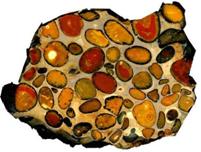Hertfordshire Puddingstone is a conglomerate of small flint pebbles bonded together by natural silica forming a solid sedimentary rock. It is one of the world's rarest rocks and like other puddingstones, its name derives from the cross section of the matrix of pebbles being akin to the fruit in a Christmas/fruit pudding.
Hertfordshire Puddingstone started its formation during the _____Q1_____ epoch some 56 million years ago when flint was eroded from the surrounding chalk and transported by water action to beaches, where they were rounded by wave erosion. The combination of falling sea levels and a brief arid period known as the Paleocene–Eocene Thermal Maximum, meant silica was drawn out from surrounding rocks into the water containing the flint pebbles. Subsequent drying then caused the silica to harden around the pebbles, trapping them in the matrix.
These precise conditions only occurred locally, so nearly all this puddingstone in the world is found within Hertfordshire. It is similar to concrete in appearance with an exceptionally hard surface that is usually quite dull; but when sliced through, it can be very attractive and worked in fine detail perpetuating a polish to show off the spectacular variety of colours in its constituent pebbles.

Puddingstone's earliest known application was during the Stone Age when it was used as a _____Q2_____ to _____Q3_____ because of its hardness. As well as being used for its physical attributes, local people also believed puddingstone warded off evil spirits and could bring good luck. These local theories have given rise to puddingstone’s alternative names of Angel stone, Hagstone or Witchstone.
This particular piece of Hertfordshire Puddingstone was procured for the parishioners of Abbots Langley by local gardener Frank Cooper in 1986 after it was excavated during the construction of the nearby stretch of the M25. Q4: When approaching the rock, what general hue does it appear to you? Q5: What is likely to be the reason for this? On examining the rock more closely, you can see that the size of the pebbles in the matrix is mostly uniform. This occurs due to the size grading of the pebbles by wave action before the silica set around them. However, larger pebbles do get caught in the matrix and this particular example shows two similar sized, obviously larger pebbles amongst it's constituent. These can be seen when looking at the rock's face nearest the library; one in the middle and one on the left hand edge. Q6: What size are these larger pebbles? _____mm/in x _____mm/in. An indication of just how hard Hertfordshire Puddingstone is comes from analysing any cracks within the stone. Q7: What do you notice about the way the cracks cut through the matrix?
Although situated on Abbots Langley's popular high street, its position is away from all of the shops and therefore probably further away than most visitors would venture; unless of course you were coming to the library or seeking an Earthcache. Parking is possible along the high street, but restrictions apply; please check signage. Alternatively, there is a large free car park a few minutes walk away, the entrance to which is indicated in the additional waypoints.
To complete this Earthcache, please fill in the blanks above and send me your seven answers via the message centre or email. Please also include a photograph of yourself or your GPS with the Puddingstone in your log, although this is not compulsory. You're welcome to log your find before sending me your answers, but please make sure they are sent within two weeks of your find or your log may be deleted.